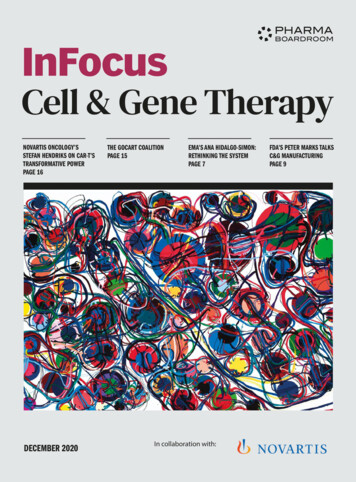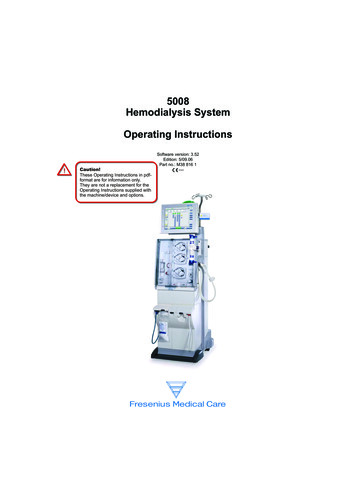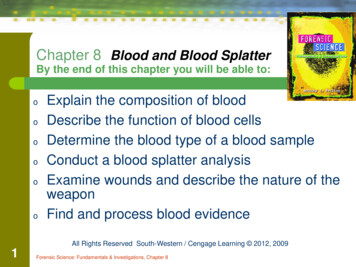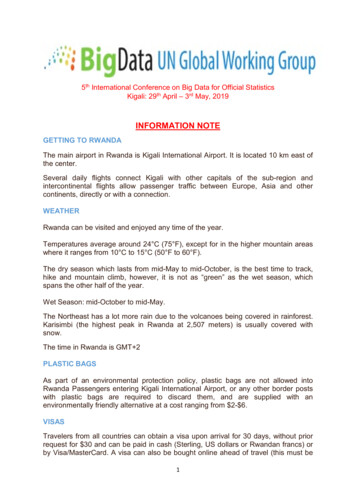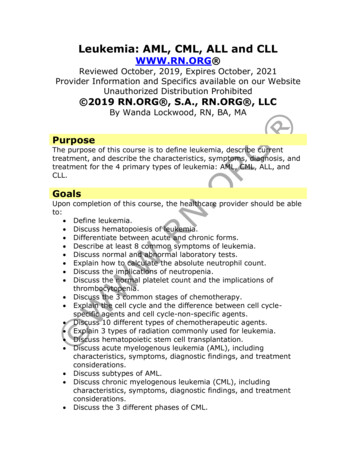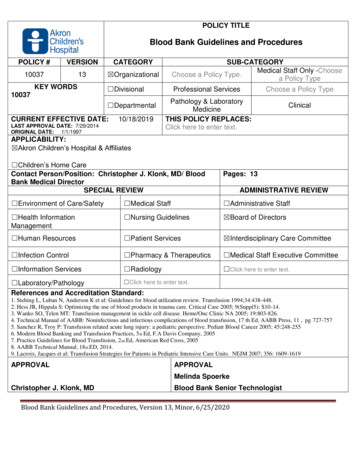
Transcription
POLICY TITLEBlood Bank Guidelines and ProceduresPOLICY #VERSIONCATEGORY1003713 OrganizationalSUB-CATEGORYMedical Staff Only -ChooseChoose a Policy Type.a Policy Type DivisionalProfessional ServicesKEY WORDS10037 DepartmentalCURRENT EFFECTIVE DATE:10/18/2019LAST APPROVAL DATE: 7/29/2014ORIGINAL DATE: 1/1/1997Choose a Policy TypePathology & LaboratoryMedicineTHIS POLICY REPLACES:Click here to enter text.ClinicalAPPLICABILITY: Akron Children’s Hospital & Affiliates Children’s Home CareContact Person/Position: Christopher J. Klonk, MD/ BloodBank Medical DirectorSPECIAL REVIEWPages: 13 Environment of Care/Safety Medical Staff Administrative Staff Health InformationManagement Nursing Guidelines Board of Directors Human Resources Patient Services Interdisciplinary Care Committee Infection Control Pharmacy & Therapeutics Medical Staff Executive Committee Information Services Radiology Click here to enter text.ADMINISTRATIVE REVIEW Click here to enter text. Laboratory/PathologyReferences and Accreditation Standard:1. Stehing L, Luban N, Anderson K et al: Guidelines for blood utilization review. Transfusion 1994;34:438-448.2. Hess JR, Hippala S: Optimizing the use of blood products in trauma care. Critical Care 2005; 9(Suppl5): S10-14.3. Wanko SO, Telen MT: Transfusion management in sickle cell disease. Heme/Onc Clinic NA 2005; 19:803-826.4. Technical Manual of AABB: Noninfectious and infectious complications of blood transfusion, 17 th Ed, AABB Press, 11 , pg 727-7575. Sanchez R, Troy P: Transfusion related acute lung injury: a pediatric perspective. Pediatr Blood Cancer 2005; 45:248-2556. Modern Blood Banking and Transfusion Practices, 5 th Ed, F.A Davis Company, 20057. Practice Guidelines for Blood Transfusion, 2 nd Ed, American Red Cross, 20058. AABB Technical Manual, 18th ED, 2014.9. Lacroix, Jacques et al: Transfusion Strategies for Patients in Pediatric Intensive Care Units. NEJM 2007; 356: 1609-1619APPROVALAPPROVALMelinda SpoerkeChristopher J. Klonk, MDBlood Bank Senior TechnologistBlood Bank Guidelines and Procedures, Version 13, Minor, 6/25/2020
Medical Director, Blood BankPURPOSE:The Blood Bank of Akron Children’s Hospital provides transfusion services and consultation inimmunohematology and transfusion medicine for all clinical and surgical areas at Akron Children’sHospital Main Campus.POLICY:SpecimensThere is no place in the laboratory where specimen identification is more important than in theTransfusion Service. The transfusion of blood is a tissue transplant and subject to many of thoselimitations and legalities, one can better keep in perspective the possible dangers. Rules for bloodbanking are established through the Federal Food and Drug Administration (FDA), the College ofAmerican Pathologists (CAP), and other accrediting agencies and will be rigidly followed.Specimens for any tests done by the Transfusion Service will not be drawn unless the patient has anidentification wristband in place.Specimens for any tests done by the Transfusion Service must be labeled properly with the followinginformation before any test will be performed and must be accompanied with the Blood BankRequisition.Patient’s first and last nameMedical record number or date of birthDate when specimen drawnCollector’s employee #Blood Bank RequisitionALL Blood Bank specimens must be accompanied by a signed Blood Bank Requisition. Twosignatures are required: collector's signature with employee number and the witness signature withemployee number. The requisition must be signed at the time of collection. The Pertinent PatientHistory and Transfusion History sections along with the desired testing and Blood Product selectionmust be filled out by the Ordering Provider, who also must sign the form (electronically in EPIC ormanually on a Blood Bank requisition). These requisitions need to be completely filled out in order tobe processed.Indications for Transfusion of Blood ProductsThese are guidelines and are not intended to serve as exclusive or all-inclusive medical indicationsfor transfusion. Transfusions may be indicated in additional clinical situations not falling within theseindications listed below.Whole Blood: (Note: it usually takes at least 3 days to obtain whole blood) very few indications forwhole blood.Blood Bank Guidelines and Procedures, Version 13, Minor, 6/25/2020
Packed Red Blood Cells (PRBC):Transfusion Guidelines for PRBCs in Infants Less than 4 Months of Age1.Hemoglobin 7g/dl with low reticulocyte count and symptomatic anemia (tachycardia,tachypnea, poor feeding).2.Hemoglobin 10g/dl and any of the following:a.On 35% oxygen hood.b.On oxygen by nasal cannula.c.On continuous positive airway pressure and/or intermittent mandatory ventilation onmechanicalventilation with mean airway pressure 6 cm of water.d.With significant tachycardia or tachypnea (heart rate 180 beats/minute for 24 hours,respiratory rate 80 beats/minute for 24 hours).e.With significant tachycardia or bradycardia ( 6 episodes in 12 hours or 2 episodes in 24hours requiring bag and mask ventilation while receiving therapeutic doses ofmethylxanthines).f.With low weight gain ( 10 g/day observed over 4 days while receiving 100kcal/kg/day).3.Hemoglobin 12 g/dl and either of the following:a.On 35% oxygen hood.b. On continuous positive airway pressure/intermittent mandatory ventilation with meanairway pressure 6-8 cm of water.4.Hemoglobin 15 g/dl and either of the following:a.On extracorporeal membrane oxygenation.b.With congenital cyanotic heart disease.Transfusion Guidelines for RBCs in Patients 4 Months of Age:1.Hemoglobin 7g/dla.Asymptomatic hemodynamically stable non-trauma patients without ongoing blood loss,medical issues, hemoglobinopathies, coagulopathies, and cardio-respiratory abnormalities whoare not about to undergo a homeostatic challenge should be considered for transfusion only ifthey are less than or equal to a hemoglobin of 7g/dl. However if their hemoglobin is less than10g/dl it would be prudent to have a valid type and screen or type or type and cross in theevent that they do drop lower.b.Emergency surgical procedure in patient with significant postoperative anemia.c.Preoperative anemia when other corrective therapy is not available.d.Intraoperative blood loss 15% total blood volume.Blood Bank Guidelines and Procedures, Version 13, Minor, 6/25/2020
2.3.4.5.Hemoglobin 8g/dl and:a.In perioperative period, with signs and symptoms of anemia.b.While on chemotherapy/radiotherapy.c.Chronic congenital or acquired symptomatic anemia.Hemoglobin 13g/dl and:a.With severe pulmonary disease.b.On extracorporeal membrane oxygenation.Sickle cell disease and:a.Cerebrovascular accident.b.Acute chest syndrome.c.Splenic sequestration.d.Aplastic crisis.e.Recurrent priapism.f.Preoperatively when general anesthesia is planned in patients with target hemoglobin of10 mg/dL and the type of surgery could result in blood loss resulting in levels below 10.Chronic transfusion programs for disorders of red cell production (e.g., β-thalassemiamajor and Diamond-Blackfan syndrome unresponsive to therapy.Transfusion Guidelines for PRBC in patients of any age:Patients who meet the criteria for the Massive Transfusion Protocol at Akron Children’sHospital and/or Acuteblood loss with hypoperfusion not responsive to other therapy.Transfusion Guidelines for Autologous Blood:For patients undergoing an elective surgical procedure with a risk of significant blood loss andsufficient time is available for them to donate in the pre-operative period. When autologousblood is obtained it should cover the needed surgery if possible. It is transfused using thesame indicators as would be used for allogeneic blood.Transfusion Guidelines for Pheno-typed Blood:Phenotyped blood is appropriate in patients who will require multiple transfusions over a longperiod of time such as; patients with hemoglobinopathies, bone marrow failure patients andoncology or burn patients who demonstrate the ability to produce antibodies.Transfusion Guidelines for Intraoperative blood salvage:Intra-operative blood salvage can be used in selected cases where transfusion is frequentlynecessary and it can decrease donor exposure by 50%. All of the salvaged blood must belabeled and the transfusion started while in the operating room and transfused within six hoursof salvage. See Intra-operative Salvage Policy.Transfusion Guidelines for Platelets1.2.3.Platelet count 5,000 to 10,000/µL with failure of platelet production.Platelet count 30,000/µL in a neonate with failure of platelet production.Platelet count 50,000/µL in stable premature infant:Blood Bank Guidelines and Procedures, Version 13, Minor, 6/25/2020
4.a.With active bleedingb.Before an invasive procedure.Platelet count 100,000/µL in sick premature infant:a.With active bleeding5.Before an invasive procedurePlatelet count 100,000/UL in patient of any agea.Undergoing CNS or Ocular surgeryb.Patient undergoing ECMOc.Multiple trauma patients actively bleedingd.Cardiac surgery patients with active bleedingWithout Thrombocytopenia1.Active bleeding in association with a qualitative platelet defect from any cause (ECMO,Cardiopulmonary Bypass, Platelet aggregation disorders that are acquired or inherited, DIC,uremia medications, etc.2.Patients with an inherited or acquired qualitative platelet defect who are about to undergo ahemostatic challenge should have their platelet count increased by 50,000/UL in routinesurgical procedures and by 100,000/UL in CNS or Ocular surgical procedures.DIC disseminated intravascular coagulation; ECMO extracorporeal membrane oxygenationTransfusion Guidelines for Plasma ProductsFresh Frozen Plasma (FFP)1.Support during treatment of disseminated intravascular coagulation.2.Replacement therapy:a.When specific factor concentrates are not available, including, but not limited to,antithrombin; protein C or S deficiency; and Factor II, Factor V, Factor X, and Factor XI deficiencies.b.During therapeutic plasma exchange when FFP is indicated.3.Reversal of warfarin in an emergency situation, such as before an invasive procedure withactive bleeding.4.According to the Massive Transfusion Protocol at Akron Children’s Hospital5.FFP is not indicated for volume expansion only or enhancement of wound healing.CryoprecipitateCryoprecipitate AHF1.Hypofibrinogenemia or dysfibrinogenemia with active bleeding.2.Hypofibrinogenemia or dysfibrinogenemia while undergoing an invasive procedure.3.Factor XIII deficiency with active bleeding or while undergoing an invasive procedure in theabsence of Factor XIII concentrate.4.Limited directed-donor cryoprecipitate for bleeding episodes in small children with hemophiliaBlood Bank Guidelines and Procedures, Version 13, Minor, 6/25/2020
A (when recombinant and plasma-derived Factor VIII products are not available).5.In the preparation of fibrin sealant.6.Von Willebrand disease with active bleeding, but only when both of the following are true:a.Deamino-D-arginine vasopressin (DDAVP) is contraindicated, not available, or does not elicit aresponse.b.If virus-inactivated plasma-derived Factor VIII concentrates (which contains von Willebrandfactor) are not available.7.According to the Massive Transfusion Protocol at Akron Children’s Hospital.Transfusion Guidelines for Other Blood Bank ProductsWhite cell reduced components are used to prevent non-hemolytic febrile transfusion reactions andalso to prevent or delay allo-immunization and platelet refractoriness in patients requiring repeatedtransfusions on a long-term basis. Cellular products at Akron Children’s Hospital (PRBC andPlatelets) are pre-leukoreduced from the Northeastern Ohio American Red Cross. Leukoreductiondoes not prevent graft versus host disease. Leukoreduction makes Cellular products CMV safe.CMV- screened components are not routinely used because leukoreduction renders products CMVsafe. CMV- screened components may be appropriate for organ donor patients.Irradiation of blood components is used to prevent transfusion associated graft versus hostdisease in patients who are immunosuppressed. It should be ordered for all directed donations, allpatients with immune deficiency, patients with malignancies who are immunosuppressed, infants lessthan 4 months of age, and solid organ/ hematopoietic transplant patients. Other immune deficiencyconditions not mentioned here should have irradiated blood ordered. When in doubt order irradiatedcellular blood components such as platelets and Packed Red Blood CellsWashing of blood components is used to reduce allergic reactions and remove unwanted elementsfrom units where they should be avoided (e.g., K , anti-T in T-activated patients).Frozen blood is used for highly allo-immunized patients where a specific donor is utilized or forautologous units collected 42 days prior to surgery.Blood Bank Guidelines and Procedures, Version 13, Minor, 6/25/2020
HLA or crossmatched platelets are used for patient’s refractory to random donor and single nonmatched donor platelets. Note: It usually takes at least four days to obtain this product.Blood Ordering and Blood Bank Test Ordering Practices:No Blood Test Ordering: Many surgical procedures only require blood replacement in rarecircumstances and hence no preoperative provision for blood for transfusion or testing is indicatedunless the patient has a history of multiple transfusions or previous antibody formation. Suchprocedures that are commonly done at ACH include but are not limited to:HerniorrhaphyCircumcision/hypospadias repairCyst/skin lesion removalSuperficial lymph node biopsyStrabismus surgeryMyringotomy tubesAdenoidectomy/tonsillectomy-in patient who have not had previous RBC transfusionsExtremity surgery distal to the knee and elbowType and Screen: In some cases, significant blood loss is a possibility, but blood would not berequired in the majority of cases. In this circumstance, a current Type and Screen should becompleted prior to starting the procedure or while the below listed condition exists. Rapid availabilityis then assured. Such procedures or conditions commonly encountered at ACH include but are notlimited to:Cardiac catheterizationLaparotomyCNS shunt insertionCleft lip/palate repairPectus repairFundoplicationMost bony procedures proximal to the knee and elbowBlood Bank Guidelines and Procedures, Version 13, Minor, 6/25/2020
Patients with multiple long bone fractures, pelvic or spine fracturesPatients admitted for observation following traumaPatients admitted for observation for possible GI bleedAny patient with a previous history of transfusion or alloantibody formationPatients admitted for complications related to HemoglobinopathySpinal fusions, pelvic osteotomies or unstable pelvic fracture repairs where cell saver can be usedCraniosynostosis repair with cell saverLevel 2 and 3 traumas should be typed and screened upon presentationTonsillectomy and adenoidectomy in patients with a history of previous rbc transfusionsType and Cross (In EPIC this is TYPE and SCREEN and PREPARE): In some cases, significantblood loss is anticipated or massive blood loss is an immediate, unavoidable risk. In these cases, aType and Screen and Prepare red cells is recommended. This should supply sufficient blood todeal with immediate circumstance and allow time to obtain additional blood as needed. Suchprocedures or conditions commonly existing at ACH include but are not limited to:Open heart surgeryCraniosynostosis repair where cell saver is not able to be usedLe Fort osteotomyVascular procedures (PDA, coarct)Spinal fusions, pelvic osteotomies or unstable pelvic fracture repairs where cell saver cannot be usedLarge tumor resection such as osteosarcoma/Ewing’s sarcoma, laparotomy for large abdominaltumors or thoracotomy for large mediastinal or pulmonary tumorsCraniotomy for evacuation of hematoma, tumor or seizure focus resectionAll level 1 traumas should have a type and prepare order upon presentation. All other trauma levelsshould be typed and screened upon presentation.If autologous or directed blood has been obtained, it will be prepared for the procedure.Products Available on a Routine BasisPacked Red Cells (PRBC)*Unit 300-400 mL of RBCs in preservative solution, HCT 50% to 60%in Adsol products and 65% to 80% in CPD* productsPlatelets* Single Donor Apheresis Platelet Unit is equivalent to six random donor platelet packs approximately 150mL to 400 mL with an average of approximately 240 mL, Single donor aphaeresisunits contain 3 x 10e11 platelets.PlasmaUnits 220-280 mLCryoprecipitateUnits 30 mLBlood is collected and supplied to us in units. Each unit of blood product is equal to one donorBlood Bank Guidelines and Procedures, Version 13, Minor, 6/25/2020
exposure. Best practice dictates that one should strive to give an adequate amount of the products tobring about the desired change; while at the same time, exposing the patient to the least number ofunits (donors) possible. The table below is an approximation of how the blood product should beordered in non- hemorrhaging patients where strict volume control is not an issue.** Blood is collectedand supplied to us in units. Each unit of blood product is equal to one donor exposure. Best practicedictates that one should strive to give an adequate amount of the products to bring about the desiredchange; while at the same time, exposing the patient to the least number of units (donors) possible.The table below is an approximation of how the blood product should be ordered in nonhemorrhaging patients where strict volume control is not an issue.**Dosing of Blood Products in Neonates and Children:Blood Components and Dosing of Small Volumes in Neonatal and Pediatric Patients who are not activelybleeding or actively consuming the blood in products.ComponentDoseExpected IncrementPacked Red Blood Cells10-15 mL/kgHemoglobin increase 2-3g/dL*Fresh Frozen Plasma10-15 mL/kg15%-20% rise in factor levels (assuming100% recovery)Platelets: Apheresis5-10 mL/kg or50,000/µL rise in platelet count (assuming1 apheresis per 60100% recovery)†70 kg of lean bodyweightCryoprecipitated AHF1-2 units/10 kg60-100 mg/dL rise in fibrinogen (assuming100% recovery)Blood is collected and supplied to us in units. Each unit of blood product is equal to one donorexposure. Best practice dictates that one should strive to give an adequate amount of the products tobring about the desired change; while at the same time, exposing the patient to the least number ofunits (donors) possible. The table below is an approximation of how the blood product should beordered in non- hemorrhaging patients where strict volume control is not an issue.**Desired volumePRBC-FFP-CRYO-PLT1 unit 300ml to400ml1 unit 220ml to280ml1 unit approximately30 ml1 Apheresis isapproximately 240ml to400ml1-50mlOrder in mlOrder in mlOrder in unitsOrder in ml51-200mlOrder in mlOrder in mlOrder in units½ apheresis201-300mlOrder in mlOrder in unitsOrder in units1 apheresis 300mlOrder in unitsOrder in UnitsOrder in units1 apheresisPRBC-Packed Red Blood Cells, FFP-Fresh frozen Plasma, Cryo-Cryoprecipitate AHF, ApheresisApheresis platelet 6 RDU with only one donor.Blood Bank Guidelines and Procedures, Version 13, Minor, 6/25/2020
Administration of Blood Products:Unless otherwise specified (i.e., patient with need for strict intake and output regulation) red cells orplasma will be dripped into all patients 10 kg using biutrol for approximating rate. You must specifyif precise rate control if a pump is needed. For neonates, red cells or plasma is issued in syringesand administered by a pump. Platelet packs and cryoprecipitate are generally dripped into patients 20 kg and given as slow I.V. push to others, although in small patients (i.e., 10 kg) a pump may beused.All blood products are administered through an appropriate filter.AT NO TIME IS THE ADMINISTRATION OF DRUGS OR FLUIDS OTHER THAN 0.9% SODIUMCHLORIDE (NACL) ALLOWED TO BE ADDED TO THE TRANSFUSION OF BLOOD OR BLOODCOMPONENTS OR TO BE RUN IN THE SAME LINE WITH BLOOD OR BLOOD COMPONENTS.ALWAYS FLUSH IV TUBING OR LOCKS WITH NORMAL SALINE BEFORE TRANSFSION OFBLOOD PRODUCTS AND AFTER TRANSFUSING BLOOD PRODUCTS PRIOR TO INSTILLINGOTHER MEDICATIONS OR FLUIDS.*Dependent on anticoagulant-preservative solution: with 3 g/dL increment for CPD and CPDA-1 and2 g/dL for AS-1, AS-3, and AS-5†Assumes 5.5 x 10e10 platelets in 50 mL of plasma (whole-blood-derived) and 3.0 x 10e11platelets in 250-300 mL plasma (apheresis).CPD citrate-phosphate-dextrose; CPDA-1 citrate-phosphate-dextrose-adenine-1; AS additivesolution.*Preservative solution can be removed from the red cells to concentrate them to a volume of 210260mL with Hct 65% to 80% and plasma can be removed from platelets to concentrate them to avolume of 25 or 50 mL for use in patients where minimizing volume is crucial. Both can also bewashed. RBCs washed have a volume of 180-200 mL/unit, washed platelets 50 mL/unit. Note:washing platelets is rarely indicated and results in significant reduction in function and survivability.*Red cells for neonates are obtained in special packs which contain either 200-240 mL packed redcells, Hct 65% to 80% or 450-410 mL whole blood** In ordering for non- hemorrhaging patients less than 5 kg; PRBC, platelets and plasma should beordered in ml and cryoprecipitate by unit. For non-hemorrhaging patients between 5 kg to 20 kg,PRBC and plasma can be ordered in ml and platelets and cryoprecipitate should be ordered in unitsor ½ units. This way you will get maximum benefit and minimum blood product exposure. For allpatients greater than 20 kg in whom exact volume is not critical, you should attempt to order bloodproducts in units where possible taking into account the approximate volumes of the units of thevarious blood products. For example, you have a 39 kg patient who is anemic and not activelybleeding or hemolyzing and you desire to raise the hemoglobin by 1g/dl. Your usual transfusionwould be 10 mL/kg which would require 390 ml. If, instead of ordering 390ml, you order one unit, thepatient will receive 320-375 mL, almost the same amount. You can then check the Hgb and see ifanother unit seems reasonable and justifiable. This way the patient is only exposed to one donor. ForBlood Bank Guidelines and Procedures, Version 13, Minor, 6/25/2020
a platelet example; you have a 15 kg child who is not extremely volume sensitive and not activelyconsuming platelets and you wish to raise the platelet count by 50,000/microliter. You calculationcalls for 150ml of platelets. You order ½ apheresis platelet which would be approximately 75-200ml.Following the transfusion you re-check the count and if you did not reach the desired effect you cangive the second ½ of the same unit with only one donor exposure.Transfusion Reaction:Transfusion of blood and blood components is ordinarily safe, but adverse effects may occur. Theseadverse effects are called Transfusion Reactions. Transfusion reactions may be acute where theonset of symptoms occurs immediately or within a short time of the commencement of thetransfusion; or, they may be delayed where they occur days or weeks afterwards.The blood bank is to be notified as soon as feasible for all suspected transfusion reactions.All remaining untransfused blood product, are to be returned to the blood bank as soon aspossible. The exceptions are volume overload and citrate toxicity as defined below. In thecase of a purely allergic or urticarial reaction, where no sign of anaphylaxis is present, theblood bank must be notified and a sample sent, but the remaining untransfused product doesnot have to be returned as described below.Acute Transfusion Reactions:1.Acute Hemolytic Transfusion Reactions (AHTR).An AHTR is triggered by an antigen-antibody reaction that activates the complement andcoagulation systems and prompts inflammatory and endocrine responses. Shock, disseminatedintravascular coagulation, acute renal failure and death may occur. Life-threatening AHTRs areusually due to ABO incompatibility. Incompatibility of other blood groups may result in an AHTR butusually they result in less severe reactions. Reactions may occur after as little as 10-15 ml ofincompatible blood has been infused. Symptoms that may occur include fever, chills, flank pain,chest pain, hypotension, nausea, hemoglobinuria, shock, generalized bleeding, back pain, and painat infusion site. Whenever any transfusion reaction including an AHTR is suspected, the transfusionmust be stopped immediately, the IV kept patent with a saline lock or saline drip and the physician orAPP are immediately notified. If the symptoms are severe and include mental status changes orchanges in vital signs that include hypoxia or shock, a code blue should be called.2.Febrile Nonhemolytic Transfusion Reactions (FNTR)A FNTR reaction involves a 1 degree or more Celsius temperature rise associated with thetransfusion, and may begin any time during the transfusion, or within four hours following itscompletion. Some FNTR reactions are caused by a recipients antibodies reacting to transfused whiteblood cells or to pyrogens in the serum of the donor which the recipient reacts to. These are usuallybenign reactions and can be minimized by giving antipyretics prior to the transfusion and by usingleukocyte-reduced blood components (all blood components at ACH are pre-leukoreduced except forwhole blood and autologus blood). Since a temperature rise of 1 degree Celsius may also be theinitial sign of several other types of transfusion reactions it is important to rule out, more serioustransfusion reactions. Therefore, a rise in temperature of one degree Celsius is treated in a fashionsimilar to a suspected acute hemolytic transfusion reaction.3.Bacterial Contamination of the Transfused ProductBacterial contamination is rare, but such reactions may be fatal. Severe reactions are characterizedby high fever, shock, hemoglobinuria, DIC, and renal failure. While platelets are the most commonBlood Bank Guidelines and Procedures, Version 13, Minor, 6/25/2020
product to be contaminated with bacteria, this phenomenon can occur with any blood product.4.Anaphylactic Reactions and Anaphylactoid Reactions (for the purposes of thisdocument both will be considered the same)Anaphylactic Reactions can present similar to “urticarial reactions” (described below) and or acutehemolytic transfusion reactions (AHTR). They usually can be distinguished from AHTR by theabsence of fever. They can usually be distinguished from urticarial reactions by occurring very earlyin the transfusion (many times after only a few ml of product is transfused) and by being much moresever. Initially hives, pruritus, andflushing can be seen similar to urticarial reactions; however, anaphylactic reactions frequentlyprogress to include stridor (laryngeal edema), wheezing (bronchospasm), and circulatory collapse(hypotension and tachycardia). Other general signs and symptoms may be present such asabdominal pain and nausea and vomiting. Causes may include anti-IgA antibodies in IgA-deficientpatients and antibodies to soluble plasma antigens or to drugs contained in transfused bloodproducts.5.Urticarial Reaction (purely allergic reaction)Urticarial reactions are characterized by flushing, hives, and itching (pruritus) with notemperature rise of more than 1 degree Celsius and no other signs of a transfusion reaction. Thismust be differentiated from an early anaphylactic reaction by lack of progression to any of the othersymptoms described above in the anaphylactic transfusion reaction section and any of the other signsof transfusion reaction. In all transfusion reactions, the treating physician or APP must evaluate thepatient according to the transfusion reaction protocol described at the end of this section. If it isdetermined by the physician or APP that the reaction that is occurring is purely urticarial, then this isone instance where the unit that is causing the reaction may be re-started cautiously under thedirection of the physician or APP. In order to accomplish this re-start, the physician or APP is toevaluate the patient to determine that significant clinical improvement has occurred followingtreatment (the treatment is prescribed by the physician or APP and usually includes anti-histamines).Then the physician or APP (or designee) must call the blood bank to determine if the clerical checkmatches, that the post transfusion DAT is negative and that there is no evidence of hemolysis in thepost transfusion sample. In such cases, if the four hour expiration from the time of issuance has notoccurred, then the transfusion may be re-started under the direction of the physician or APP and withclose monitoring. In such cases the Blood Bank ultimately may not receive the untransfused portionof the unit in question.6.Circulatory OverloadRapid increases in blood volume are poorly tolerated by patients with compromised cardiac orpulmonary status or chronic anemia with expanded plasma volume. Even transfusion of smallamounts of blood may cause circulatory overload in infants. These are recognized by showing signsand symptoms of congestive heart failure with associated chest x-ray findings of pulmonary edema.Clinical findings may include pulmonary rales, edema and increased central venous pressure.Laboratory findings may include an elevated serum Brain Natriuretic Peptide (BNP). The workup ofthis reaction is determined by the physician or APP and the Blood Bank should be notified for recordkeeping. It is important for the physician or APP to differentiate this reaction from TRALI (see nextsection) because in circulatory overload the untransfused portion of the blood product does notnecessarily need to be returned to NORC for testing and the blood bank does not need to performBlood Bank Guidelines and Procedures, Version 13, Minor, 6/25/2020
additional workup.7.Transfusion Related Acute Lung In
Blood Bank Senior Technologist . Blood Bank Guidelines and Procedures, Version 13, Minor, 6/25/2020 Medical Director, Blood Bank . For patients undergoing an elective surgical procedure with a risk of significant blood loss and sufficient time is available for them to donate in the pre-operative period. When autologous
